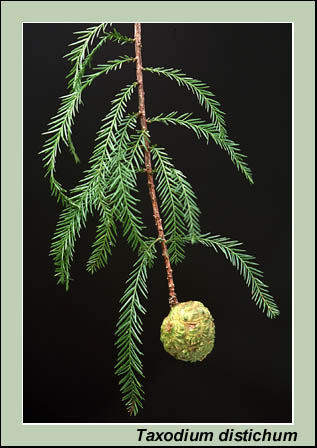Bald Cypress/Baldcypress
Taxodium distichum
Family: Cupressaceae
Natural History

Leaves and seed cone of bald cypress | Photo credit: Larry Korhnak, University of Florida
Bald cypress is a long-lived, deciduous wetland species that grows along rivers, streams, and creeks, as well as in swamps with slow moving water. It is a legendary tree of the Deep Sout - known for its "knees," moss-draped crown, and buttressed trunk. It can grow 100-150 feet tall and three to six or more feet in diameter. This tree can live up to 600 years.
Some river edges still have stumps of giant cypress trees that were logged in the early 1900s. A few old giants live in parks across Florida. The crown is open and narrowly pyramidal. Old-growth bald cypress has a flattened crown usually dangling with Spanish-moss (Tillandsia usneoides). This tree has a very distinctive root system that consists of numerous "sinkers" that provide anchorage - which are supported by a wide-spreading, lateral system of shallow roots.
Bald cypress can be easily confused with pond cypress (Taxodium ascendens) which is closely related. Careful attention to detail can differentiate these two species. Pond cypress has smaller, scale-like leaves pressed on the twigs. A twig of pressed pond cypress leaves resembles a pine needle pointing up or out from the branchlet. Bald cypress leaves are linear and featherlike, and the twigs hang down looking more pendulous than pond cypress twigs and leaves. Also, pond cypress tends to occur in still-water wetlands rather than in the flowing-water wetlands of the bald cypress habitat.
"Knees" are present in both pond cypress and bald cypress root systems when they are growing in water. Cypress "knees" (or pneumatophores) are cone-shaped extensions of the root system protruding from the ground. The purpose of these knees remains a mystery. Some scientists believe the knees provide structural support, and may be the tree's way of obtaining oxygen for the roots during flooded conditions. Other scientists believe the knees may have evolved as a form of defense against the footsteps of ancient large herbivores.
